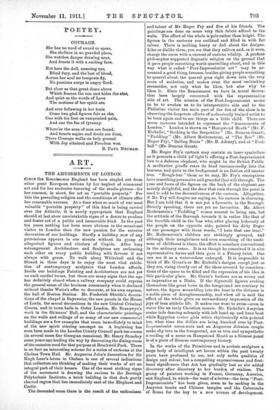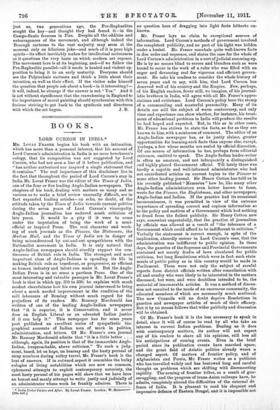ART.
THE AMUSEMENTS OF LONDON.
iSiwcE the Renaissance England has been singled out from other great European nations by her neglect of communal art and for her exclusive fostering of the studio picture—for her concern, in short, for art as "portable property." For this the prevailing religion and the conditions of climate offer her reasonable excuses. At a time when so much of our most valuable "portable property" of this kind is being carried over the Atlantic, it is surely appropriate that England should at last show unmistakable signs of a desire to produce and foster art of a public and immovable kind. In the past ten years nothing has been more obvious to the occasional visitor to London than the new passion for the exterior decoration of our buildings. Hardly a building now of any pretensions appears in our streets without its group of allegorical figures and clusters of Cupids. After long estrangement Architecture and Sculpture are embracing each other on every public building with fervour if not always with grace. To walk along Whitehall and the Strand in these days is to enjoy the most vital exhibi- tion of contemporary sculpture that London affords. Inside our buildings Painting and Architecture are not yet on such cordial terms, but there are many signs that the age has definitely closed when a railway company could express the general sense of the business community when it declined without thanks Watts's offer to decorate, at his own expense, the hall of Euston Station. Mr. Frederick Shields's decora- tions of the chapel in Bayswater, the new panels in the House of Lords, the mural decorations in the new Central Criminal Courts, and in town halls in Outer London, Mr. Brangwyn's work in the Skinners' Hall, and the characteristic paintings on the walls and ceilings of so many of our new commercial buildings are a few examples that come immediately to mind of the new spirit stirring amongst us. A beginning has even been made in the London County Council park tea-rooms (in several cases fine Georgian mansions), Mr. Henry Strachey some years ago leading the way by decorating the dining-room of the mansion used for that purpose at Brockwell Park. There is on foot an interesting scheme for a series of cartoons at the Chelsea Town Hall. Mr. Augustus John's decoration for Sir Hugh Lane's house in Chelsea is one of several indications that collectors are thinking of making their works of art an integral part of their houses. One of the most striking signs of the movement is drawing the curious to the Borough Polytechnic Institute, a brick building in that drab partly charted region that lies immediately east of the Elephant and Castle.
The decorated room there is the result of the enthusiasm
and talent of Mr. Roger Fry and five of his friends. The paintings are done on some very thin fabric affixed to the walls. The effect of the whole is pale rather than bright. The figures in the cartoons are outlined and filled in with flat colour. There is nothing heavy or dull about the designs. Like or dislike them, you see that they enliven and, as it were, charge the room with a current of curious vitality. A profane philosopher supported dogmatic religion on the ground that it gave people something worth quarrelling about, and in this way what is called " Post-Impressionist art " may be ac- counted a good thing, because, besides giving people something to quarrel about, the quarrel goes right down into the very roots of aesthetics, and makes even the most unthinking reconsider, not only what he likes, but also why he likes it. Since the Renaissance we have in mural decora- tion been largely concerned with the representative side of art. The mission of the Post-Impressionist seems to be to awaken us to its interpretative side and to the Philistine visitor the main part of the fun of the show is in observing the desperate efforts of a classically trained artist to be born again and to see things as a little child. There are seven cartoons intended to represent the " Amusements of London." London is shown on " Hampstead Heath" (Mr. F. Etchells), "Bathing in the Serpentine" (Mr. Duncan Grant), "Paddling" (Mr. Albert -Rothenstein), at "The Zoo" (Mr. Roger Fry), "Sailing Boats " (Mr. B. Adeney), and at " Foot- ball" (Mr. Duncan Grant).
Mr. Roger Fry's cartoon may contain an inner symbolism as it presents a child (of light?) offering a Post-Impressionist bun to a dubious elephant, who might be the British Publics. A meditative giraffe rears its head unconcernedly into the heavens, and quite in the background is an Italian old master tree. " Rough-hue " them as he may, Mr. Fry's conceptions have something persuasive and graceful that will through. The rose and faces of the figures on the back of the elephant are naively delightful, and the door that cuts through the panel is used to add to the decorativeness of the cartoon. Altogether, if Mr. Fry will forgive me saying so, his cartoon is charming. But I am told that it is not yet a favourite in the Borough. Strictly speaking, there are yet no favourites. Mr. Albert Rothenstein's " Paddling " comes nearest to being one, but the attitude of the Borough towards it is rather like that of the horrible child in the 'bus who, after glaring hideously at the people on the opposite side, pointed his dirty finger at one passenger with these words, "I hate that one least." Mr. Rothenstein's children are strikingly grouped, and although their naughtiness and even something of the nasti- ness of childhood is there, the effect is somehow conventional in the ordinary sense. It is as though he conceived it in nice representative terms and then gave it a Fitzroy twist. One can see it as a water-colour enlarged. It is impossible to think of Mr. Grant's or Mr. Etchells's designs except just as they are, rising clearly out of the ideas aroused by considera- tions of the space to be filled and the expression of his idea in this particular place. Mr. Grant's bathers are as wrong and as imperative as a Blake. If the Signorelli figures arching themselves like great bows in the foreground are contrary to nature, the figure scrambling into the boat in the distance is a noble piece of draughtsmanship, and when all is said the effect of the whole gives an extraordinary impression of the joys of lean athletic life. It makes one want to swim—even in water like an early Christian mosaic. Mr. Etchells's Assyrian costar lads dancing solemnly with left hand up and knee bent while Egyptian costar girls retire rhythmically with pointed toe, what time the dollies are being knocked over by Post- Impressionist cocoa-nuts and an Augustus Jobnian couple make shy love in the foreground, are as true and sympathetic a reading of a scene on Hampstead Heath as a Sienese panel is of a piece of Sienese contemporary history.
In the works of the Primitives and in archaic sculpture a large body of intelligent art lovers within the past twenty years have professed to see, not only noble qualities of design and colour, but a compelling expressiveness and first- band significance that Art has gradually lost as she added discovery after discovery to her burden of realism. The group of painters working in France, Germany, America, and England, to which—for want of abetter—the term " Post- Impressionists " has been given, seem to be seeking in the Assyrian tombs and Chinese temples and the Catacombs of Rome for the key to a new avenue of development. just as, two generations ago, the Pre-Raphaelites sought the key—and thought they had found it—in the Campo-Santo frescoes in Pisa. Despite all the oddities and extravagances of the movement, and although indeed the Borough cartoons to the vast majority may seem at the moment only an hilarious joke—and much of it is pure high spirits—its effect inevitably makes for intellectual seriousness as it questions the very basis on which modern art reposes. The movement here is at its beginning, and—if we follow the Pre-Rapbaelito parallel—all it needs is heated and violent op- position to bring it to an early maturity. Everyone should see the Polytechnic cartoons and think a little about their intention, as well as their effect. If the visitor asks himself the question that people ask about a book—is it interesting ?— it will, indeed, be strange if the answer is not " Yes." And it is not without significance that the reawakening in England to the importance of mural painting should synchronize with this furious striving to get back to the synthesis and directness



















































 Previous page
Previous page